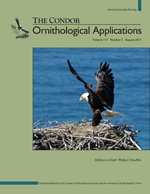Detection probability during point counts and its associated variables are important considerations for bird population monitoring and have implications for conservation planning by influencing population estimates. During 2008–2009, we evaluated variables hypothesized to be associated with detection probability, detection latency, and behavioral responses of male Golden-winged Warblers in pastures in the Monongahela National Forest, West Virginia, USA. This is the first study of male Golden-winged Warbler detection probability, detection latency, or behavioral response based on point-count sampling with known territory locations and identities for all males. During 3-min passive point counts, detection probability decreased as distance to a male's territory and time since sunrise increased. During 3-min point counts with playback, detection probability decreased as distance to a male's territory increased, but remained constant as time since sunrise increased. Detection probability was greater when point counts included type 2 compared with type 1 song playback, particularly during the first 2 min of type 2 song playback. Golden-winged Warblers primarily use type 1 songs (often zee bee bee bee with a higher-pitched first note) in intersexual contexts and type 2 songs (strident, rapid stutter ending with a lower-pitched buzzy note) in intrasexual contexts. Distance to a male's territory, ordinal date, and song playback type were associated with the type of behavioral response to song playback. Overall, ~2 min of type 2 song playback may increase the efficacy of point counts for monitoring populations of Golden-winged Warblers by increasing the conspicuousness of males for visual identification and offsetting the consequences of surveying later in the morning. Because playback may interfere with the ability to detect distant males, it is important to follow playback with a period of passive listening. Our results indicate that even in relatively open pasture vegetation, detection probability of male Golden-winged Warblers is imperfect and highly variable.
How to translate text using browser tools
24 June 2015
Variables associated with detection probability, detection latency, and behavioral responses of Golden-winged Warblers ( Vermivora chrysoptera)
Kyle R. Aldinger,
Petra B. Wood
ACCESS THE FULL ARTICLE

The Condor
Vol. 117 • No. 3
August 2015
Vol. 117 • No. 3
August 2015
distance
playback
point count
population estimate
season
song
time




